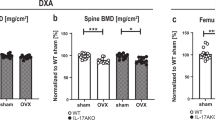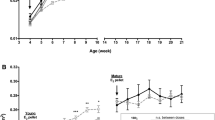Abstract
Interleukin-6 (IL-6) can inhibit growth of a variety of tumors including B16 routine melanoma. IL-6 levels increase with age and after ovariectomy or menopause. The adrenal androgen, dehydroepiandrosterone sulfate (DHEAS), can lower serum IL-6 levels in aged mice. Therefore, we hypothesized that ovariectomy would induce elevations of serum IL-6 capable of inhibiting B16 melanoma growth in mice. Additionally we postulated that DHEAS would be able to reverse the ovariectomy-induced increase in IL-6, thus abrogating IL-6’s antitumor effect.
To explore our hypothesis ovariectomy or sham surgery was performed on C57BL/6 mice followed by inoculation with B16 melanoma. The mice then received either oral DHEAS or placebo. Ovariectomy resulted in significant weight gain without altered food intake. IL-6 levels were elevated comparably in all groups after ovariectomy or sham surgery. Administration of DHEAS had no effect on these parameters. Tumor size was not significantly different between test groups, however the ovariectomized mice receiving DHEAS had a trend towards larger tumor volume compared to the other test groups. Additionally, splenocytes from ovariectomized mice receiving DHEAS demonstrated enhanced tumor cell killing in vitro. We conclude that ovariectomy does not elevate serum IL-6 to a level which results in inhibition of B16 tumor cell growth and may in fact enhance tumor growth in conjunction with DHEAS.
Similar content being viewed by others
References
Mulé JJ, McIntosh NK, Jablons DM and Rosenberg SA: Antitumor activity of recombinant interleukin 6 in mice. J Exp Med 171:629–636, 1990.
Sun WH, Kreisle RA, Philips AW and Ershler WB: In vivo and in vitro characteristics of interleukin 6-transfected B16 melanoma cells. Cancer Res 52:5412–5415, 1992.
Ray A, Prefontaine KE and Ray P: Down-modulation of interleukin-6 gene expression by 17b-estradiol in the absence of high affinity DNA binding by the estrogen receptor. J Biol Chem 269:12940–12946, 1994.
Jilka RL, Passeri G, Girasole G, Cooper S, Abrams J, Broxmeyer H and Manolagas SC: Estrogen loss upregulates hematopoiesis in the mouse: a mediating role of IL-6. Exp Hematol 23:500–6, 1995.
Pottratz ST, Bellido T, Mocharla H, Crabb D and Manolagas SC: 17b-Estradiol inhibitsexpression of human promoter-reporter constructs by a receptor-dependent mechanism. J Clin Invest 93:944–950, 1994.
Pioli G, Basini G, Pedtazzoni M, Musetti G, Ulietti V, Bresciani D, Villa P, Bacchi A, Hughes D, Russel M and Passeri M: Spontaneous release of interleukin-1 and interleukin-6 by peripheral blood mononuclear cells after oophorectomy. Clin Sci 83:503–507, 1992.
De M, Sanford TR and Wood GW: Interleukin-1, interleukin-6, and tumor necrosis factor alpha are produced in the mouse uterus during the estrous cycle and are induced by estrogen and progesterone. Develop Biol 1151: 297–305, 1992.
Kalimi M, Shafagoj Y, Loria R, Padgett D and Regelson W: Anti-glucocorticoid effects of dehydro-epiandrosterone (DHEA). Mol Cell Biochem 131:99–104, 1994.
Regelson W, Loria R and Kalimi M: Dehydroepiandrosterone (DHEA)—the “mother steroid”. I. Immunologic action. Ann N Y Acad Sci 719:553–63, 1994.
Schwartz AG and Pashko LL: Cancer chemoprevention with the adrenocortical steroid dehydroepiandrosterone and structural analogs. J Cell Biochem Suppl 73–9, 1993.
Schwartz AG and Pashko LL: Role of adrenocortical steroids in mediating cancer-preventive and age-retarding effects of food restriction in laboratory rodents. [Review]. Journal of Gerontology 49:B37–41, 1994.
Gordon GB, Shantz LM and Talalay P: Modulation of growth, differentiation, and carcinogenesis by dehydroepiandrosterone. Adv Enzyme Regul 26:355–382, 1987.
Schultz S and Nyce JW: Inhibition of isoprenylation and p21 membrane association by dehydroepiandrosterone in human colonic adenocarcinoma cell in vitro. Cancer Res 51:6563–6567, 1991.
Regelson W and Kalimi M: Dehydroepiandrosterone (DHEA) — the multifunctional steroid. Ann N Y Acad Sci 719:564–575, 1994.
Regelson W, Loria R and Kalimi M: Hormonal intervention: “buffer hormones” or “state dependency”. The role of dehydroepiandrosterone (DHEA), thyroid hormone, estrogen and hypophysectomy in aging. Annals NY Acad Sci 521:260–273, 1988.
Orienteich L, Brind JL, Rizer RL and Vogelman JH: Age changes and sex differences in serum dehydroepiandrosterone sulfate concentration throughout adulthood. J Clin Endocrinol Metab 59:551–555, 1984.
Daynes RA, Araneo BA, Ershler WB, Maloney C, Li G and Ryu S: A dysregulation in the production of interleukin-6 with normal aging: Probable linkageto the age associated depression in dehydroepiandrosterone (DHEA) and its sulfated derivative. J Immunol 1150:5219–5230, 1993.
Ershler WB, Sun WH, Binkley N, Gravenstein S, Volk MJ, Kamoske G, Klopp RG, Roecker EB, Daynes RA and Weindruch R: Interleukin-6 and aging: Blood levels and mononuclear cell production increase with advancing age and in vitro production is modifiable by dietary restriction. Lymphokine Cytokine Res 12:225–230, 1993.
Ho S, Stebler B and Ershler WB: Interleukin-2 and syngeneic bone marrow transplantation in a murine fibrosarcoma model. Lymphokine Cytokine Res 10:101–104, 1991.
Pross HF, Baines MG, Rubin P, Shragge P and Patterson MS: Spontaneous human lymphocyte-mediated cytotoxicity against tumor target cells. IX. The quantitation of natural killer cell activity. J Clin Immunol 1:51–63, 1981.
Hansen MB, Nielsen SE and Berg K: Re-examination and further development of a precise and rapid dye method for measuring cell growth/cell kill. J Immunol Methods 119:203–210, 1989.
Van Snick J, Cayphas S, Vink A, Uttenhove C, Coulie PG, Rubira MR and Simpson RJ: Purification and NH2-terminal amino acid sequence of a new T-cell-derived lymphokine with growth factor activity for B cell hybridomas. Proc. Natl. Acad. Sci. USA 83:9679–9683, 1986.
Jablons CM, Mule JJ, McIntosh JK, Sehgal PB, May CT, Huang CM, Rosenberg SA and Lotze MT: IL-6/IFN-B-2 as a circulating hormone: Induction by cytokine administration in humans. J Immunol 142:1542–1547, 1989.
McIntosh JK, Jablons DM, Mule JJ, Nordan RP, Rudikoff S, Lotze MT and Rosenberg SA: In vivo induction of IL-6 by administration of exogenous cytokines and detection of de novo serum levels of IL-6 in tumor-bearing mice. J Immunol 143:162–167, 1989.
Araneo BA, Dowell T, Diegel M and Daynes RA: Dihydrotestosterone exerts a depressive influence on the production of interleukin-4 (IL-4), IL-5, and g-interferon, but not IL-2 by activated murine T cells. Blood 78:688–699, 1991.
MacEwen EG and Kurzman ID: Canine obesity: Role of the adrenal steroid dehydroepiandrosterone. J Nutrition 121:S51–S55, 1991.
Nestler JE, Clore JN and Blackard WG: Metabolism and actions of dehydroepiandrosterone in humans. J Steroid Biochem 40:599–605, 1991.
Suzuki T, Suzuki N, Daynes RA and Engleman EG: Dehydroepiandrosterone enhances IL2 production and cytotoxic effector function of human T cells. Clin Immunol Immunopathol 61:202–211, 1991.
Mortola F and Yen SSC: The effects of oral dehydroepiandrosterone on endocrine-metabolic parameters in postmenopausal women. J Clin Endocrinol Metab 71:696–704, 1990.
Shenkin A, Fraser WD, Series J, Winstanley FP, McCartney AC, Burns HJG and van Damme J: The serum interleukin-6 response to elective surgery. Lymphokine Res 8:123–127, 1989.
Lu C and Kerbel RS: Interleukin-6 undergoes transition from paracrine growth inhibitor to autocrine stimulator during human melanoma progression. J Cell Bio 1120:1281–1288, 1993.
Beattie CW, Ronan SG and Amoss Jr MS: Estrogens influence the natural history of Sinclair swine cutaneous melanoma. Cancer Res 51:2025–2035, 1991.
Boccuzzi G, Aragno M, Brignardello E, Tamagno E, Conti G, Di Monaco M, Racca S, Danni O and Di Carlo F: Opposite effects of dehydroepiandrosterone on the growth of 7,12-dimethylbenz(a)anthracene-induced rat mammary carcinomas. Anticancer Res 12:1479–1484, 1992.
Gabrilovac J, Radacic M, Osmak M and Boranic M: Opposing influence of age on the growth and colony-forming ability of mouse melanoma B16 and mammary adenocarcinoma: correlation with natural killer activity. Cancer Immunol Immunother 32:45–50, 1990.
Araneo BA, Marion L, Woods H and Daynes RA: Reversal of the immunosenescent phenotype by dehydroepiandrosterone: hormone treatment provides an adjuvant effect on the immunization of aged mice with recombinant hepatitis B surface antigen. J Inf Dis 167:830–840, 1993.
Author information
Authors and Affiliations
About this article
Cite this article
Keller, E.T., Pugh, T.D., Sun, W.H. et al. Evaluation of ovariectomy and dehydroepiandrosterone sulfate administration on interleukin-6 levels and B16 melanoma growth in mice. AGE 19, 75–81 (1996). https://doi.org/10.1007/BF02434086
Issue Date:
DOI: https://doi.org/10.1007/BF02434086




